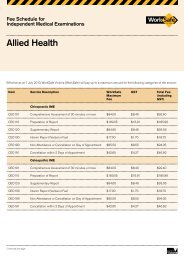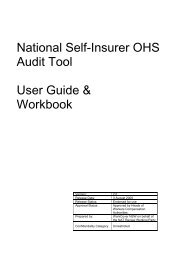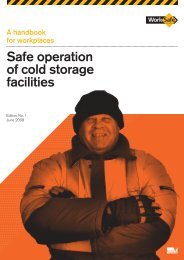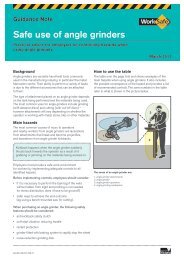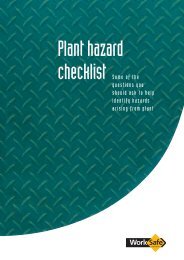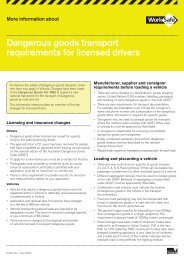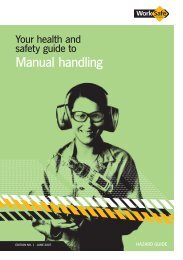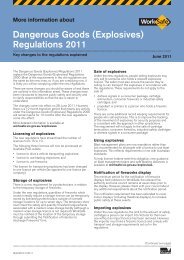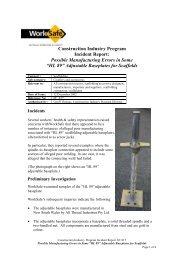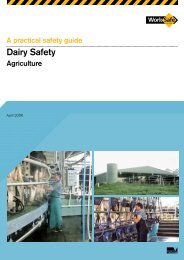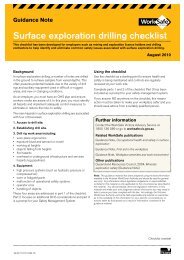a guide to safety in the wood products ... - WorkSafe Victoria
a guide to safety in the wood products ... - WorkSafe Victoria
a guide to safety in the wood products ... - WorkSafe Victoria
You also want an ePaper? Increase the reach of your titles
YUMPU automatically turns print PDFs into web optimized ePapers that Google loves.
PLANTTra<strong>in</strong><strong>in</strong>g and supervisionEmployees who operate, ma<strong>in</strong>ta<strong>in</strong> or are required <strong>to</strong> work <strong>in</strong> close proximityof plant must be tra<strong>in</strong>ed and supervised <strong>in</strong> <strong>the</strong> operation of that plant.Complacency has been identified as one of <strong>the</strong> fac<strong>to</strong>rs lead<strong>in</strong>g <strong>to</strong> many <strong>in</strong>jurieswhen operat<strong>in</strong>g new plant. The <strong>in</strong>experience of employees is a potential hazardand employers should ensure new or <strong>in</strong>experienced employees are not left <strong>to</strong>work alone on hazardous plant. O<strong>the</strong>r risk control solutions that can be used <strong>in</strong>clude:• ensur<strong>in</strong>g <strong>the</strong> right mach<strong>in</strong>e is used for <strong>the</strong> right purpose• controll<strong>in</strong>g production output <strong>in</strong> <strong>the</strong> workplace <strong>to</strong> ensure <strong>safety</strong> is still a priority• a grad<strong>in</strong>g system related <strong>to</strong> tra<strong>in</strong><strong>in</strong>g for opera<strong>to</strong>rs and ma<strong>in</strong>tenance• consultation between management and employees about guard<strong>in</strong>g and mach<strong>in</strong>eoperat<strong>in</strong>g procedures.Push pads and push sticksThese <strong>to</strong>ols are used as aides <strong>to</strong> assist opera<strong>to</strong>rs when us<strong>in</strong>g <strong>wood</strong> work<strong>in</strong>g plant.For <strong>in</strong>stance, a push pad is used <strong>to</strong> better isolate <strong>the</strong> opera<strong>to</strong>r’s hands from <strong>the</strong>cutt<strong>in</strong>g blade on a buzzer. Push sticks are often used <strong>to</strong> push timber through arip saw. When us<strong>in</strong>g <strong>the</strong>se mechanical aids <strong>the</strong> follow<strong>in</strong>g adm<strong>in</strong>istrative controlsshould be followed:Push sticks should never be used <strong>to</strong>:• remove off cuts from a runn<strong>in</strong>g mach<strong>in</strong>e• heat up a blade by apply<strong>in</strong>g a friction force us<strong>in</strong>g <strong>the</strong> stickKick backA common problem associated with <strong>the</strong> manufacture of timber <strong>products</strong> is <strong>the</strong>‘kick back’ associated with rotat<strong>in</strong>g plant and mach<strong>in</strong>ery. This poses a risk <strong>to</strong> <strong>the</strong>opera<strong>to</strong>r when <strong>the</strong> timber be<strong>in</strong>g sawn or mach<strong>in</strong>ed b<strong>in</strong>ds <strong>to</strong> <strong>the</strong> blade and ‘kicksback’ <strong>to</strong>wards <strong>the</strong>m. In <strong>the</strong>se <strong>in</strong>stances <strong>the</strong> guard<strong>in</strong>g or riv<strong>in</strong>g knives may havebeen removed. O<strong>the</strong>r situations that can lead <strong>to</strong> issues with ‘kick back’ <strong>in</strong>cludeknots <strong>in</strong> <strong>the</strong> timber or us<strong>in</strong>g <strong>the</strong> wrong <strong>to</strong>ol (ei<strong>the</strong>r <strong>to</strong>o powerful or not powerfulenough) for <strong>the</strong> task, or a saw blade that is blunt or worn.GUARDINGThere are many types of guard<strong>in</strong>g systems available <strong>to</strong> guard dangerous parts ofmach<strong>in</strong>ery <strong>to</strong> prevent bodily access. If guard<strong>in</strong>g is <strong>to</strong> be used as a control measure,<strong>the</strong> employer is required <strong>to</strong> ensure that any guard designed for <strong>the</strong> plant will, sofar as is practicable, prevent access <strong>to</strong> <strong>the</strong> danger po<strong>in</strong>t or area of <strong>the</strong> plant.The guard<strong>in</strong>g that is <strong>to</strong> be <strong>in</strong>stalled on<strong>to</strong> plant should be designed and <strong>in</strong>stalled bya suitably qualified and competent person. There may be <strong>in</strong>stances where <strong>the</strong>guard<strong>in</strong>g is <strong>to</strong> be designed and <strong>in</strong>stalled by an electrical contrac<strong>to</strong>r or someoneo<strong>the</strong>r than <strong>the</strong> manufacturer or supplier. It is important <strong>to</strong> ensure whoever designsand <strong>in</strong>stalls guard<strong>in</strong>g is familiar with <strong>the</strong> current Australian Standard AS4024 –2006, Safety of Mach<strong>in</strong>ery, Part 1201: General Pr<strong>in</strong>ciples – Basic term<strong>in</strong>ology andmethodology and <strong>the</strong> current Australian Standard that relates <strong>to</strong> <strong>the</strong> equipmentbe<strong>in</strong>g guarded.The plant guard<strong>in</strong>g hierarchy is as follows:1. Permanently fixed physical barrier2. Interlocked physical barrier3. Physical barrier (fixed guard)4. Presence sens<strong>in</strong>g system8 WORKSAFE VICTORIA / A GUIDE TO SAFETY IN THE WOOD PRODUCTS MANUFACTURING INDUSTRY




